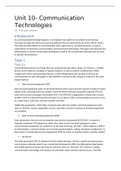Unit 10- Communication
Technologies
A2 – A Bespoke Solution
Introduction
As a Communications Design Engineer, my employer has asked me to compile some training
materials for both new hires and current employees that are listed below all of the criteria. Hence,
the study provides details on communication tools, signal theory, and data elements, as well as
explanations of electronic communication and transmission techniques. The paper also discusses the
effectiveness of various transmission techniques as well as the transmission methods that are used
in specific circumstances.
Task 1
Task 1a
Communication devices are things that can communicate with other things. For instance, a mobile
phone can be linked to a desktop or laptop computer as well as another mobile phone. When
coupled with other communication devices, certain refrigerators may function as devices for
communication as well. Although it's also feasible to connect locally, using the Internet is the most
typical method.
Data terminal equipment (DTE)
Data terminal equipment refers to terminals that transform user input into signals or back into input
signals (DTE). Queuing chains are another name for these terminals. Equipment used for DTE and
data link terminals exchanges information (DCE). The DTE/DCE categorization scheme was created
by IBM. A DTE is a data terminal element that, in accordance with a communication protocol, serves
as a data source, data sink, and data transfer controller.
Unlike data equipment, which often communicates with one another, terminal equipment rarely
does so. Printers, routers, application servers, and other common instances of terminal equipment
are available.
Data circuit-terminating equipment (DCE)
Data connections that are not connected to data terminal equipment (DTE) (DCE). A modem is
typically considered DTE equipment, which also refers to data terminal equipment or data
communication equipment (or computer). At the data exchange, the DCE—which might be a DTE or
an intermediary—performs duties such channel synchronisation, coding, and signal conditioning. To
link circuit or channel data terminal equipment (DTE) to a DCE, an interface device could be needed.
3G/4G/5G
The third generation (3G) of wireless networks and technology. 3G was a significant improvement
over previous networks when it was created and developed in 2001 to enable devices like laptops
and mobile phones to access the Internet wherever they are. The term "4G" refers to a mobile
communication technology that replaces 3G and offers faster wireless internet access. The fifth-
, generation wireless standard known as 5G is capable of connecting almost everything, including
equipment, items, and other gadgets.
GPRS
In energy metering systems, the GPRS communication channel, together with the CSD channel, is the
most popular and most effective method for data transfer.
In GSM networks, GPRS is a packet data transfer technique that enables connections to distant
devices through the Internet (TCP/IP).
The technique operates on the following tenet: time slots are assigned to each segment of the radio
channel (time slots).
While GPRS transmission takes place simultaneously via numerous channels not used by phone calls,
CSD mode only ever uses one slot. As a result, radio network resources are used more effectively.
The maximum transmission rate on GPRS networks is 85.6 Kbps, and channel bandwidth may reach
21.4 Kbps in one slot (sometimes 115.2 Kbps).
Mobile phone
Modern mobile devices may now connect to many networks in various ways. Users can access the
Internet through a mobile network, Bluetooth, Chromecast, or Apple TV over a local area network
(LAN).
Laptop
Laptops can handle both wired and wireless connectivity, and they can be connected to any network
via an ethernet cable. Wi-Fi and other wireless local networks are accessible to anybody who have
wireless capabilities. Laptops can be equipped with the Bluetooth function to allow them to connect
to other devices or Bluetooth-enabled devices that lack other connectivity options.
Netbook
A netbook is a compact, low-cost laptop that was primarily created for Internet access. Because they
were primarily designed to be Internet service clients, netbooks often had lower hardware
requirements than consumer laptops of the time. Despite the fact that netbooks are no longer
widely used, they have evolved into various products like Google's Chromebook and mobile devices,
particularly tablet computers, typically running mobile operating systems like iOS or Android.
Task 1b
Digital signalling methods
A phase in the digital signal processing (DSP) process used to assess and enhance performance is
signal analysis and modification. DSP is often used to discover filtering mistakes or to compress
analogue signals in transit. This method involves utilising different mathematical and computational
approaches on analogue and digital industrial signals to get a signal of greater quality than the
original signal. Digital signal processors (DSPs) or machines with equal capabilities and the capacity
to execute their own DSP processing algorithms perform this specific sort of signal processing. DSPs
often employ signal processing techniques and algorithms following analogue to digital signal
conversion.




